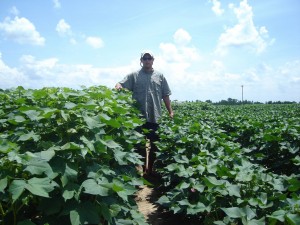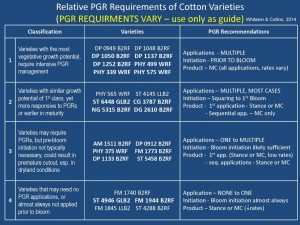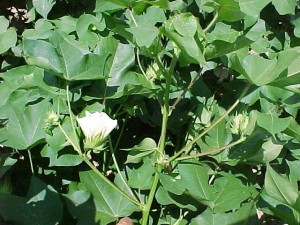At this point, much of the earlier planted cotton is squaring and it is time to consider our options and begin applying plant growth regulators (PGRs). I want to share information related to the timing of these applications and various strategies we can use with PGRs. First, recalling our objective with the application of PGRs is important. We are wanting to decrease the activity of gibberellic acid (a natural plant hormone) resulting in a shorter than normal plant.
The benefits of working with this size cotton plant include;
1. Decrease in lodging, prevent plants from getting to tall with heavy boll load and falling over.
2. Keeping the plant canopy short assists in decreasing boll rot and helps prevent hardlock. This positive effect is due to improved drying and air flow to bolls and lint.
3. Improved penetration of all chemicals used.
4. Improves harvests efficiency.
As you can see, there are numerous benefits with the application of PGRs. However, yield response to PGRs is inconsistent. Dr. Guy Collins, UGA Cotton agronomist, states that most of the time (65-70% of time) PGRs have no affect on yield. Dr. Collins suggest that if you do see a response in yield it is most likely due to indirect effects (increased light penetration, diversion of photosynthates to boll, improved harvests).
We have three basic choices of products to choose from to help us achieve this overall reduction in plant size.
1. Mepiquat Chloride – 0.35 lbs. of active ingredient/gl. Several trade names available.
2. Pentia – Mepiquat Pentaborate – 0.82 lbs. of active ingredient/gl. Claims to be more rainfast.
3. Stance – Mepiquat Chloride(0.736 lbs. of active ingredient/gl.) + Cyclanilide (0.184lbs. active ingredient/gl.) The amount of mepiquat chloride in this product is double the amount found in standard mepiquat chloride and will be used at a much lower rate. For example, 6.5 oz. use rate of standard mepiquat chloride is equal to 3 oz.use rate of Stance. The cyclanilide ingredient in this product acts as a synergist to mepiquat chloride.
When we apply PGRs we are only affecting the upper 9-10 inches of plant. Most of the PGR activity will occur in the upper 4-5 nodes providing slow down rate of terminal growth. This shortened terminal growth will allow the developing boll load to catch up with new growth.
The use of PGRs becomes even more important for later planted cotton. Later planted cotton would be that cotton that was planted between June 7 – June 15. When we are in this later planting window, we really only have a 3-4 week bloom period to make crop. So, we need timely PGR applications to improve retention on lower nodes. PGRs play a major role in later planted cotton production.
The environment is going to be the main indicator for the need of PGRs. Any conditions that promote rank/excessive growth will require the application of PGRs. I have attached a chart listing relative PGR requirements of cotton varieties. This information, developed by Dr. Guy Collins and Dr. Jared Whitaker, is only be used as a tool and to supplement the consideration of current environmental conditions and information available.
I want to list a few plant measurement options to help determine when to apply PGRs. Dr. Collins suggest to keep in mind the overall plant size relative to where it is in bloom period. At the end of the season, UGA recommends that ideally we would like to see, no cotton less than 36″ tall and no cotton more than 50-55″ tall. This cotton plant height range is tall enough to support good boll load but not too tall that it results in negative effects produced by rank cotton.
PGR Plant Measurement Tools:
1. Consider current plant height relative to target end season plant height.
2. Nodes above white flower, if greater than 9 or 10 nodes, consider slowing the plant down with PGR application.
3. Internode distance near plant terminal provides us the cotton plant’s current growth rate. This is the best indicator of current plant growth. Look between 4-5 true leaf if we have 3″ or more of growth consider PGR application.
4. Height to node ratio. But, this doesn’t measure current growth rates only assesses overall growth rate.
5. Fruit retention.
Once you have determined the need for PGR application, you have three basic application strategies. It is important to remember that timeliness of application is more important than rate. We can achieve more growth suppression by being timely than by using higher rates.
1. Low Rate, Multiple Applications – Make 3 to 4 applications of low PGR rates @ 6-8 oz. This application technique begins at first square and is reapplied every 10-14 days until first bloom.
2. Modified Early Bloom – Make 2 to 3 applications of moderate PGR rates @ 8-10 oz., beginning at 8-10 leaf stage. This is usually followed by another application at first bloom and if needed at mid bloom. Rates will go up as plant size increases.
3. Early Bloom – Make 1 to 2 applications of high PGR rates @ first bloom. A mid bloom application is necessary in some situations. Use caution when applying this strategy, especially in early maturing varieties and in dryland situations. We do not want to force pre-mature cut out with applications of PGRs while plant is under stressed conditions. If cotton appears wilted no PGRs are necessary. The sun and dry weather are conducting all plant growth regulation needed.
There is no one PGR plan that works for every situation. PGR decisions have to made on a case by case and field by field evaluation strategy.



